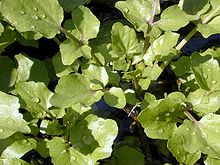Our website is made possible by displaying online advertisements to our visitors.
Please consider supporting us by disabling your ad blocker.
Nasturtium (plant genus)
| Nasturtium | |
|---|---|

| |
| Nasturtium microphyllum, a watercress, in Hawai'i | |
| Scientific classification | |
| Kingdom: | Plantae |
| Clade: | Tracheophytes |
| Clade: | Angiosperms |
| Clade: | Eudicots |
| Clade: | Rosids |
| Order: | Brassicales |
| Family: | Brassicaceae |
| Genus: | Nasturtium W.T.Aiton[1] |
| Species | |
|
See text. | |
Nasturtium (/nəˈstɜːrʃəm/) is a genus of a small number of plant species in the family Brassicaceae (cabbage family) commonly known as watercress or yellowcress.[2] The best known species are the edible Nasturtium officinale and Nasturtium microphyllum. Nasturtium was previously synonymised with Rorippa, but molecular evidence supports its maintenance as a distinct genus more closely related to Cardamine than to Rorippa sensu stricto.[3][4]
These plants are related to garden cress and mustard, noteworthy for a peppery, tangy (pungent) flavor. The name Nasturtium comes from the Latin nasus tortus, meaning "twisted nose", in reference to the effect on the nasal passages of eating the plants. Nasturtium foliage is used as food by the caterpillars of certain Lepidoptera, including Orthonama obstipata (The Gem).
One species, Nasturtium gambellii, is federally listed in California as an endangered species.[5]
- ^ Cite error: The named reference
POWO_331795-2was invoked but never defined (see the help page). - ^ NRCS. "Nasturtium". PLANTS Database. United States Department of Agriculture (USDA). Retrieved 18 July 2015.
- ^ Al-Shehbaz, I. A.; Price, R. A. (1998). "Delimitation of the genus Nasturtium (Brassicaceae)]". Novon. 8 (2): 124–126. doi:10.2307/3391978. JSTOR 3391978.
- ^ Al-Shehbaz, I. A.; Beilstein, M. A.; Kellogg, E. A. (2006). "Systematics and phylogeny of the Brassicaceae (Cruciferae): an overview". Plant Systematics and Evolution. 259 (2–4): 89–120. doi:10.1007/s00606-006-0415-z. S2CID 21816920.
- ^ U.S. Fish and Wildlife Service (September 2011). "Rorippa gambellii [Nasturtium gambelii] (Gambel's watercress) 5-Year Review: Summary and Evaluation" (PDF). Retrieved 27 March 2020.
Previous Page Next Page


